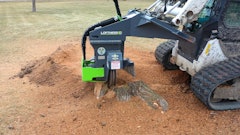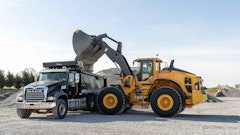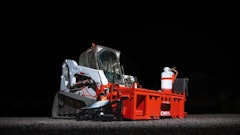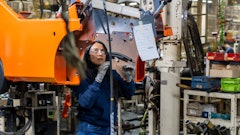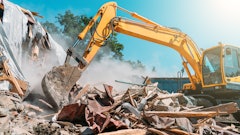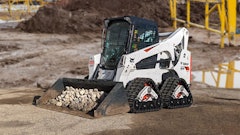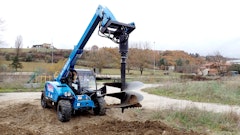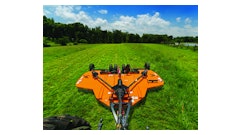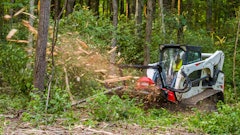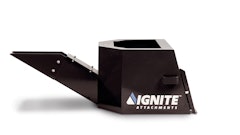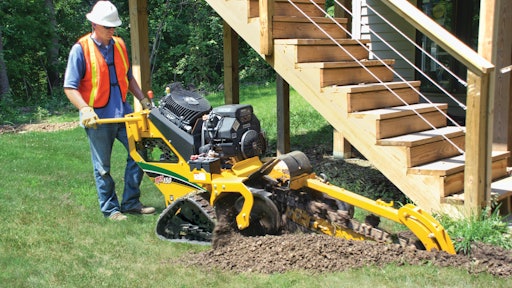
There are many different kinds of trenching units available for customers, and many benefits to both a dedicated trenching unit and a trenching attachment. What matters when shopping out these attachments is the work that’s being done and the area it’s being done in. Working with your customer to determine what type of jobs they’re doing will help you both decide what unit they ultimately need.
[Purpose in life]
A walk behind trenching unit was made for the sole purpose of digging a trench. The horsepower is designed to handle the stress that digging a trench will put on a machine. If your customer only has trenches to dig, push them towards a dedicated unit that was purpose built just for that application.
“For the horsepower and package size, dedicated units are going to perform this function better than a piece of equipment where trenching is not its main function,” says Jeri Lamerton, public relations at Ditch Witch.
A walk behind trencher typically leaves a smaller footprint than other options, both in length and width. “This allows the operator the ability to trench in more confined spaces,” adds Lamerton.
Jon Kuyers, product manager for underground products at Vermeer, agrees. “These units are very maneuverable. They can get into difficult to reach places, like in between gates and in backyards. It does a nice job to get in those hard to reach areas where trenching is often needed. Plus with some of the track options that exist today, they are also minimally invasive and don’t cause a lot of turf disturbance,” adds Kuyers.
For a most customers, especially if they are new to renting equipment, the idea of using a large piece of machinery can be daunting. A dedicated unit with just one purpose can put a customer at ease when they picture using the equipment.
"Customers can easily learn how to use this piece of equipment in a matter of minutes by just reading the operating manual," says Kuyers.
"The controls are going to be simpler because it only has one function and set of directions," says Jackie Leonard from Barreto Manufacturing. "This will make it easier to use for the rental customer."
[A tool for every job]
Most customers who are interested in renting though, have a big job in mind that may require many pieces of equipment. If they need to do more than just trenching, it might be a good idea to show them what a mini-excavator with attachments can do for them.
"In contrast to a dedicated unit, the compact excavator can trench, dig foundations, dig ponds, place pipe or stone and clear rubble," says Sam Norwood, manager, commercial worksite products sales and marketing at John Deere Construction & Forestry.
Mini excavators also have a long reach on the arm, which can be a huge advantage to trenching in tight spaces. “With the long reach on a compact excavator, you can get into really tight locations,” says Katie Altoff, attachment product specialist at Bobcat. “You can put mats under the tracks and not have to worry about tearing up the ground turf, then use the arm to drive the trencher back and forth. That way, you might not have to move quite as often as you may need to with a dedicated trencher. You’re able to use the house of the excavator and the arm to move the trencher where you need it to be and take turf sensitivity into consideration.”
"Plus, with an offset boom, compact excavators can dig right along a foundation while trenchers can only operate within 9” - 12” parallel to a foundation," adds Norwood. "Soil can then be loaded directly into a truck once removed from the ground." This can be a huge advantage if you have a deep trench to dig since there is no need for an additional piece of equipment to be brought on site to remove the dirt and relocate it.
“The appeal is that a lot of jobs want to excavate and dig, as well as trench,” says Tom Connor, excavator product specialist at Bobcat. “You can do both with an excavator, whereas if you rented a trencher for a day, you’re going to end up digging drop boxes or connection boxes by hand if the trencher is the only thing you’ve got.”
“If you have an excavator and want to do a couple projects all at once, you have lots of different opportunities with an excavator,” Altoff adds.
[The best you can do]
If your customer has a large trench to dig, or many trenches to dig, the mini-excavator route with a trenching attachment may not be the best way to go. “Mini excavators generally run smaller diesel engines with hydraulic pumps,” says Kuyers. “An auxiliary pump would run the trencher circuit to the attachment. Generally when you’re trying to track the machine and trench with the attachment, you’re draining a lot of horsepower. It’s not necessarily the most efficient operation since it’s not generally designed to handle a lot of hydraulic flow and torque, which trenchers require.”
Most customers have many jobsites to visit and several trenches to dig. This may also lean your customer to a dedicated unit. “The walk behind trencher is typically lighter weight and easier to trailer to and from jobs,” says Lamerton. “In addition, it is easier for the operator to trench a consistent depth with a walk behind trencher over a mini excavator with a trenching attachment.”
In the end, you can lead your customers to making the best decision for their project by asking questions about the job they’re doing, and then putting the right tools in their hands to get it done in the most productive way possible. Leonard agrees. "The key to determining productivity is in having the proper tool for the job," she says. "It wouldn’t be efficient to use a 35hp machine to dig an 18 or 24” trench. In some situations, the additional horsepower of a multi-attachment unit might help, but you have to be sure to match the machine to the project."











